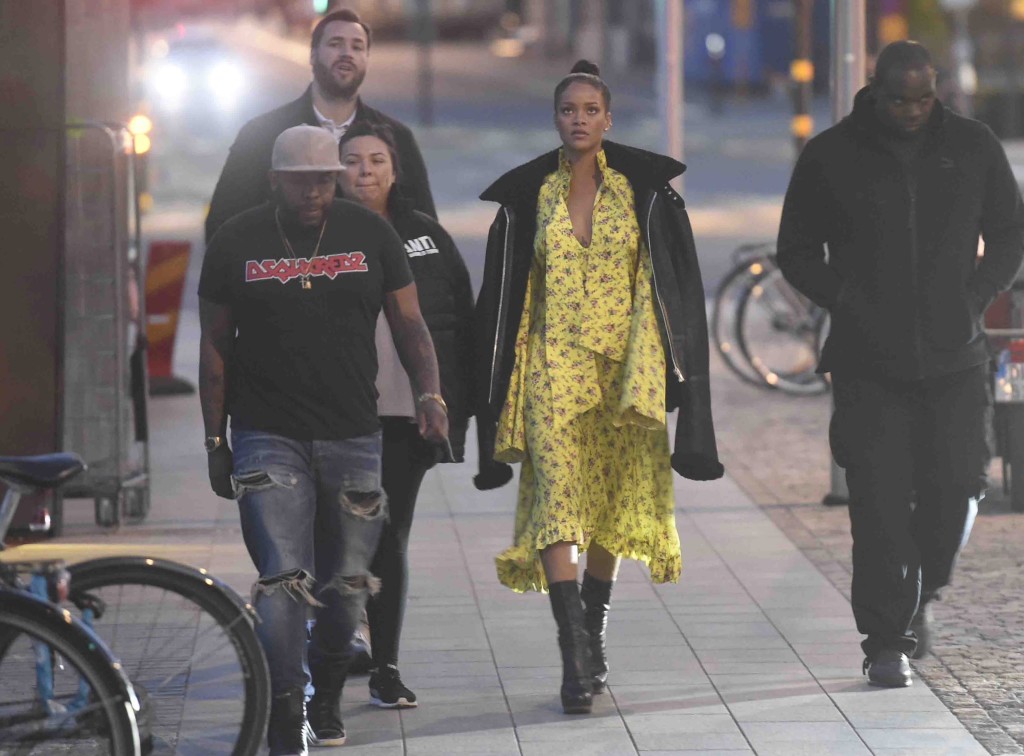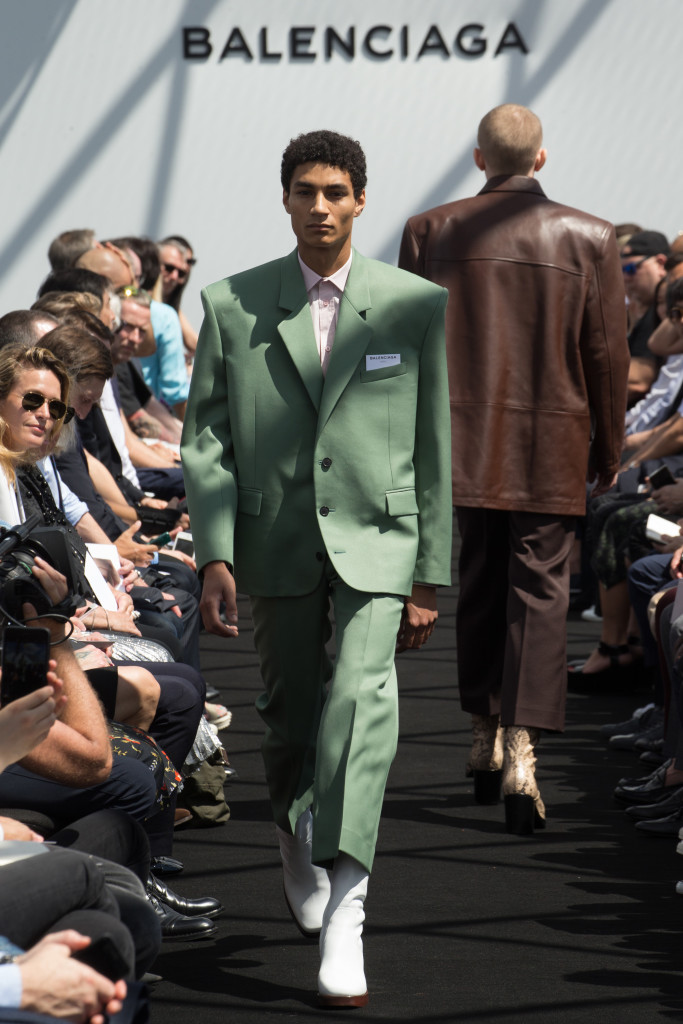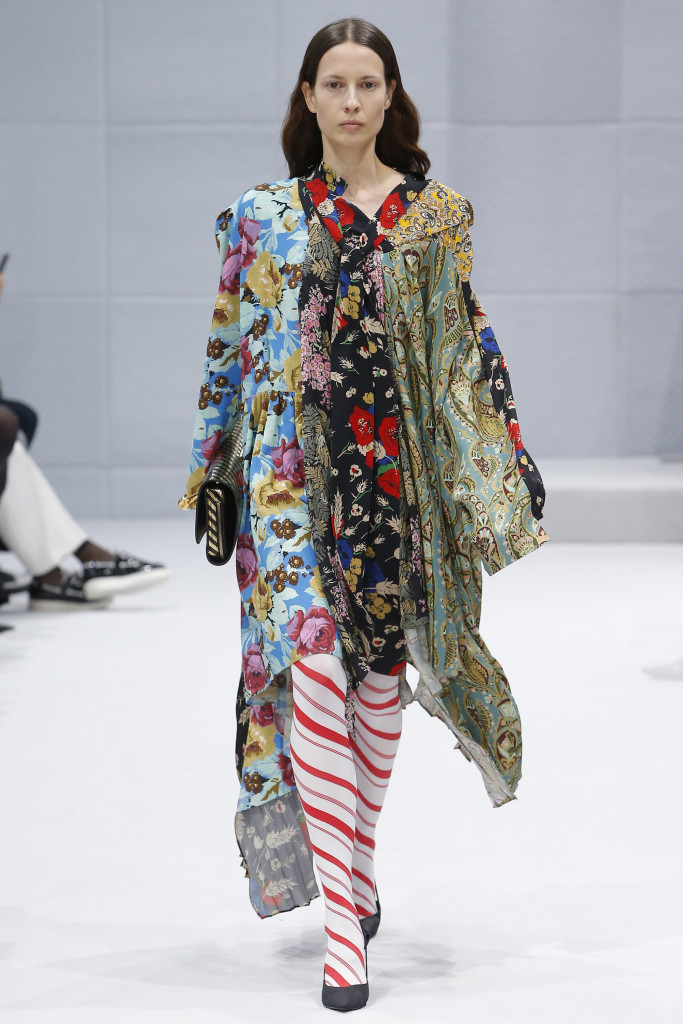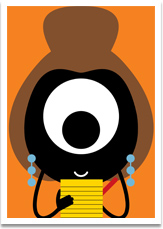Suzy Menkes talks to the designer about his pragmatic approach at Balenciaga
“May the Bridges I Burn Light the Way” reads the T-shirt Demna Gvasalia wore as he stood backstage at the Vetements show in Paris.
When he became the new Artistic Director of Balenciaga in 2015 and whenever he appears with his brother Guram, his choice of clothing is always the same: not the bold, over-sized silhouettes and wide shoulders that he learned from working at Martin Margiela, but just a humble, street-wise sweat top and recycled jeans.
“I think of uniforms quite a bit,” said Demna, 35, referring back to a childhood spent in the Soviet Union. “I love social uniforms – what the message means for somebody. I used to wear security T-shirts and people would think I am a security guy. It’s the connotation of clothes. Without people knowing you, it brings a message. I think it comes from the lack of diversity in a period of my youth. Everybody dressed the same because there was no choice.”
The impact of plain and simple clothes, with a powerful, underlying message, turned Vetements, meaning “clothes” in French, from an unknown fashion collective showing in a Paris gay bar or a downtown Chinese restaurant, into a brand that seemed to define the social upheavals across the world. And now, with Demna as Artistic Director of Balenciaga, the essence of exclusive haute couture, his work expresses a dramatic change in the character of high fashion.
The designer himself, with a background in economics and the experience of working at Louis Vuitton, first with Marc Jacobs and then Nicolas Ghesquière, insists that the choice of venues for a Vetements show is not deliberately controversial. (Although controversy was inevitable when he presented clothes with an aggressive attitude in a church and followed that up with a presentation in the highly commercial retail environment of French fashion department store Galeries Lafayette.)
”It’s not against the system – I feel that ‘anti’ is almost too much of a statement for what we did and how we function,” says Demna, who turned a basic hoodie into a worldwide object of desire, with the help of eager customer Kanye West (What better endorsement than Kanye’s playful tweet, “I’m going to steal Demna from Balenciaga”?).
“Whether it is Vetements or Balenciaga, it’s not against anything – it’s really just about finding the better way to survive today and doing things that make sense to me,” says the designer, claiming that his venue choices were about “the cheapest place I could find”. His first Balenciaga show, held in an empty former television studio, was also far away from the gilt chairs and velvet cushions of haute couture.
Demna and Guram were born in Georgia, in the north-western area of Abkhazia, into an extended family that the designer describes as “almost a gypsy clan” and “like in southern Italy where cousins are called brothers”.
“But I always wanted to get out of all that – I was definitely an outsider,’ said Demna, whose childhood was ruptured at age 12, when a civil war forced the family to leave home with “nothing but photo albums” and then to lead a peripatetic life.
“Six!” announced Demna when I asked how many languages he spoke. ”I speak Russian, Georgian, English, French, Italian, German – and a little bit of Flemish.” The latter came from his three years at fashion college in Antwerp under legendary teacher Linda Loppa.
“She really changed my view on fashion because she had this very pragmatic approach of a buyer, but always with an immense knowledge of fashion,” Demna said. “She would say: do you know someone who would like to wear that? If you don’t, then you have to change it.”
After three years in Antwerp, when he had to choose “between buying three metres of fabric or a can of something to eat”, Demna graduated in 2006 and joined Margiela – shortly before the designer left the house that bore his name. “For me it was like an MA in fashion being there,” Demna explained. “Understanding the concept and how you need to destroy something to create the new.”
When Demna came to Balenciaga, he took the same approach, wanting “to discover the method of Cristóbal’s work, his approach, how he saw a woman, his mentality behind his creative process”. On the runway, the first women’s show presented a sporty, modern version of Balenciaga’s codes: for instance, turning the famous 1950s couture coats that stood out like sculptures around the body into giant bomber jackets.
I found it hard to imagine Demna, who admits to “having a silence phobia and always needing to have a very loud sound when I work”, in the atelier of the whisper-quiet Cristóbal. But he found the house, which is part of the Kering luxury group, to be “really structured with a very organised team. It makes life very easy. Even in two and a half days I can do an enormous amount of work”.
Compare that experience to Vetements itself, with its loose group of fashion enthusiasts, including muse and stylist Lotta Volkova, making bad taste look good, and, of course, Demna’s brother Guram, with his four degrees in law and business.
“The blood link is the biggest challenge – we can’t fire each other so it stays in the family,’ says Demna. “My brother is important because he really manages everything, while I do the creative part. Everything else is his strategic thinking about distribution and sales. He has some novel ideas about this, so it is all good exchange.”
I asked Guram about his business policy and received a deep and powerful analysis of how Vetements is playing with the supply and demand curve in a rare strategy to “produce one less piece than is needed so it is sold out – so people know that if they don’t buy it now, they could lose the opportunity”.
With Demna, I go back to the Georgian family tree and a childhood in the Soviet Union where “toothpaste wasn’t called ‘Colgate’ – there was only one”; and where his half-French Jewish grandmother in her lace maxi skirts and jewellery painted with nail varnish was the lone figure daring to be different.
“The lack of diversity defined this drive and hunger for putting many things together – it became almost a cultural bulimia in terms of music, art and the flow of information after the Soviet Union collapsed,” Demna said.
“By diversity, I mean in terms of creative approach,” he continued. “It’s a mix and match of many things. In my adolescent years, until 1993, we were living in the Soviet Union; we had no information. The first ever fashion magazine I saw was Vogue.”
I asked Demna how his parents – who insisted he study business and economics after he left school – viewed his life in fashion.
“Not until I went to Balenciaga,” he said. “Then they finally accepted me as a fashion designer. But I have very much a business approach. I don’t see it as a dreamy world of fantasy but as a business and concept. It’s pragmatism.”







